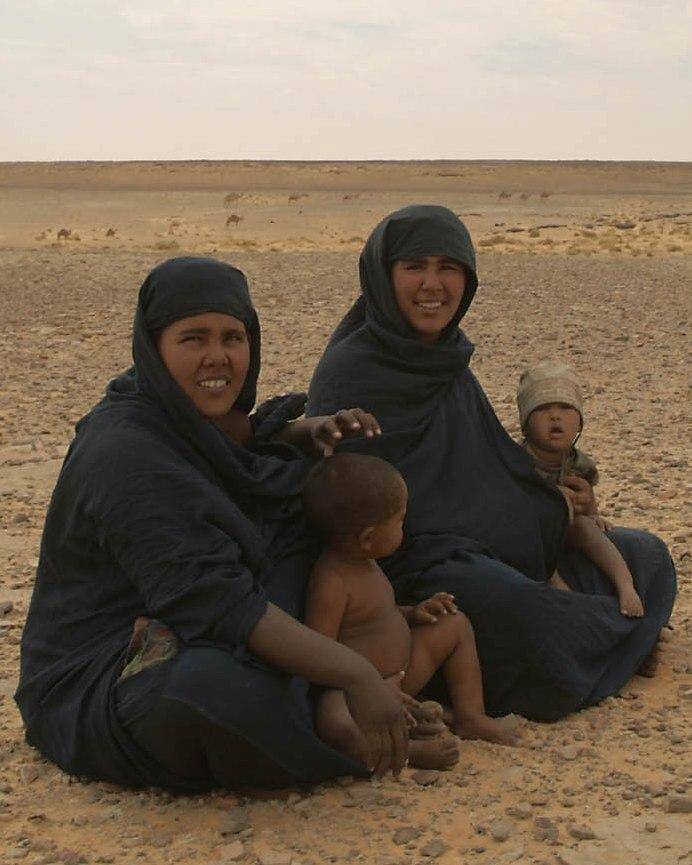
Mauritania

Figure 1.--Here we see two bedouin mothers with their children somewhere in the Mauritanian western Saharan Desert. The West African country of Mauritania is a meeting point between the African south and the Arab noth. It is also is extremely arid. That ethnic divide and geography and climate have played a major role in the country's history.
|
|
Mauritania is an Arab North African country at the juncture with Black Africa. And it is, as a result, a country split between an Arab north and an African south. It is an Atlantic coast country. The only country of the Magreb without a Mediterranean coast. While Mauritnia is largely desert, ecology of coastal waters is highly productive. The Banc d'Arguin interacts with the adjoining systems of the open Atlantic with its upwelling engine. The Banc d'Arguin functions as a tropical pocket in a temperate surrounding. Mauritania is also part of West Africa's Sahel region. The country is located south of Morocco and Algeria, west of Mali, and north of Senegal. The climate is very arid and the territiry includes large streaches of the Sahara. Thus despite the large area, there is a very small population. Only the Senegal River Valley in the south is well watered. The population includeds primarily moors--the Maur of Arab-Berber origins. Blacks dominate the south. The Portuguese reached the coast at an early stage of the voyages attempting to find a sea route to the East (15th century). The French established a protectorate (1903). It becamea colony (1920). After World War II it joined the Frebch Community (1958). France granted independence (1960). We do have a page on Mauritanian history. Mauritania annexed the southern third of the former Spanish Sahara (Western Sahara) (1976). It quickly decided to relinquished it after 3 years of damaging raids by the Polisario guerrillas seeking independence. After years of dictatorial rule, opposition parties were legalized and a new constitution approved (1991). Two multiparty presidential elections since then are widely viewed as flawed. Mauritania continues to be a one-party state. And their continues to be ethnic tensions between its dominant Maur populace and Black minority. Mauritania is one of Africa's poorest countries. Most of the population depends on farming and livestock. The economy is heavily dependent on mineral resources. Iron ore accounts for about 50 percet of the country's exports. There is also copper mining. Other exports include various animal products, gum arabic, fish, and dates.
Geography
Mauritania is an Arab North African country at the juncture with Black Africa. And it is, as a result, a country split between an Arab north and an African south. It is an Atlantic coast country. The only country of the Magreb without a Mediterranean coast. While Mauritnia is largely desert, ecology of coastal waters is highly productive. The Banc d'Arguin interacts with the adjoining systems of the open Atlantic with its upwelling engine. The Banc d'Arguin functions as a tropical pocket in a temperate surrounding. Mauritania is also part of West Africa's Sahel region. The country is located south of Morocco and Algeria, west of Mali, and north of Senegal. The climate is very arid and the territiry includes large streaches of the Sahara. Thus despite the large area, there is a very small population. Only the Senegal River Valley in the south is well watered.
Etnicity
The population includeds primarily moors--the Maur of Arab-Berber origins. Blacks dominate the south. And their continues to be ethnic tensions between its dominant Maur populace and Black minority.
The Portuguese reached the coast at an early stage of the voyages attempting to find a sea route to the East (15th century). The French established a protectorate (1903). It becamea colony (1920). After World War II it joined the Frebch Community (1958). France granted independence (1960). We do have a page on Mauritanian history. Mauritania annexed the southern third of the former Spanish Sahara (Western Sahara) (1976). It quickly decided to relinquished it after 3 years of damaging raids by the Polisario guerrillas seeking independence. After years of dictatorial rule, opposition parties were legalized and a new constitution approved (1991). Two multiparty presidential elections since then are widely viewed as flawed. Mauritania continues to be a one-party state.
Economy
Mauritania is one of Africa's poorest countries. Most of the population depends on farming and livestock. The economy is heavily dependent on mineral resources. Iron ore accounts for about 50 percet of the country's exports. There is also copper mining. Other exports include various animal products, gum arabic, fish, and dates.
HBC

Navigate the Boys' Historical Clothing Web Site:
[Return to the Main African country page]
[Introduction]
[Activities]
[Biographies]
[Chronology]
[Cloth and textiles]
[Clothing styles]
[Countries]
[Topics]
[Bibliographies]
[Contributions]
[FAQs]
[Glossaries]
[Images]
[Links]
[Registration]
[Tools]
[Boys' Clothing Home]
Navigate the Boys' Historical Clothing national pages:
[Return to the Main Mauritanian page]
[Return to the Main African page]
[Algeria]
[Cape Verde Islands]
[Democratic Republic of the Congo]
[Gabon]
[Lessotho]
[Madagascar]
[Mali]
[Morocco]
[Senegal]
]South Africa]
[Uganda]
[France]
[Portugal]
Created: 9:21 AM 1/22/2011
Last updated: 6:56 PM 6/11/2013



